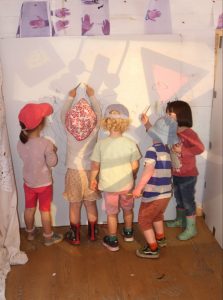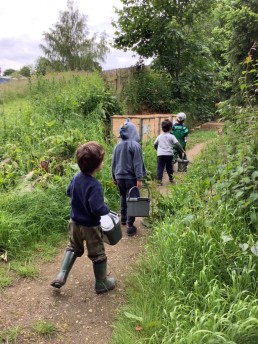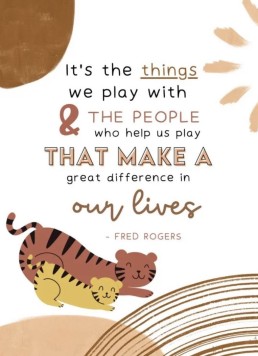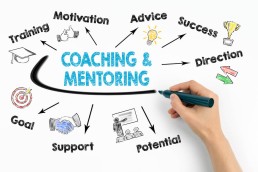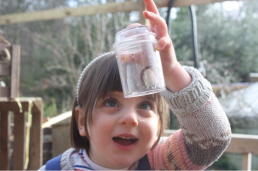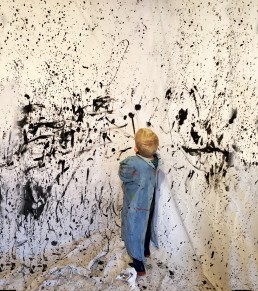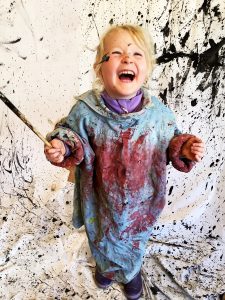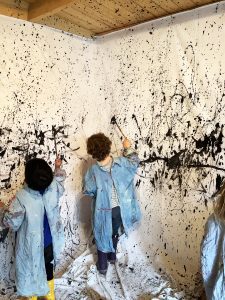Compost Collective
Inspiring Green Habits
At Inspirations Nurseries, we believe in nurturing not only the minds of our little ones but also instilling in them a deep sense of environmental responsibility. Thanks to Foodwise Leeds our latest initiative; 'Compost Collective' is underway and aims to educate children about the importance of composting and empower them to make a positive impact on the planet, starting from an early age.
Find out more about the amazing Food Wise-

In this blog post, we will delve into the significance of teaching composting to children and how educators play a vital role in fostering a sustainable mindset.
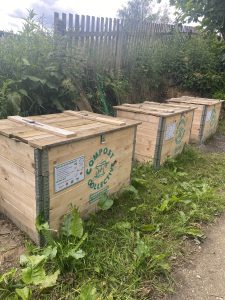
The Importance of Composting:
Composting is a natural process that transforms organic waste into nutrient-rich soil. By composting, we divert organic waste from landfills, reduce greenhouse gas emissions, and enrich the soil for future plant growth. Educating children about composting not only teaches them about the cycle of life but also installs in them an understanding of the interconnectedness of all living things. It helps children develop a sense of responsibility towards the environment and empowers them to take action to protect it.
Starting Early:
Children have a remarkable capacity for learning and absorbing information, making early childhood an ideal time to introduce them to the concept of composting. By exposing children to composting at a young age, we lay the foundation for a lifetime of environmentally conscious choices. Starting early also allows children to witness the entire composting process, from collecting food scraps to observing the decomposition and transformation into nutrient-rich soil. This hands-on experience fosters a deep connection with nature and enables children to appreciate the value of waste reduction and resource conservation.
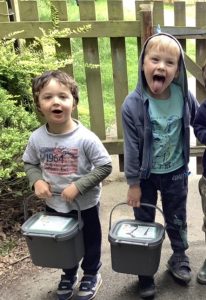
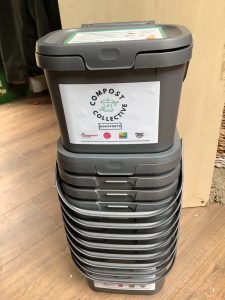
Catalysts for Change: Educators
As educators, we have the privilege and responsibility to shape young minds and inspire them to become environmentally conscious individuals. By incorporating composting into our curriculum, we can create an immersive learning experience that goes beyond the classroom walls. Through interactive activities, storytelling, and gardening projects, we can engage children in meaningful discussions about the importance of composting and its positive impact on the environment. By involving children in the entire composting process, we empower them to become active participants in sustainable practices.
Benefits of Composting Education:
Teaching children about composting provides numerous benefits. Firstly, it instills in them a sense of environmental stewardship, nurturing a generation that cares deeply about the planet's well-being. Secondly, composting education encourages critical thinking and problem-solving skills as children learn about decomposition, nutrient cycles, and the science behind composting. It also promotes teamwork and cooperation as children work together to collect and manage compost materials. Additionally, composting education fosters a sense of responsibility and self-sufficiency as children take ownership of the composting process.
Inspiring a love for nature and sustainable practices in young children is a powerful way to create a greener and brighter future. By introducing composting education in early childhood, we equip children with the knowledge and skills to make a positive impact on the environment. At Inspirations Nurseries, our Composting Project aims to cultivate a sense of environmental responsibility, foster a deep connection with nature, and empower children to become agents of change. Together, let's sow the seeds of sustainability and nurture a generation that cherishes and protects our beautiful planet.
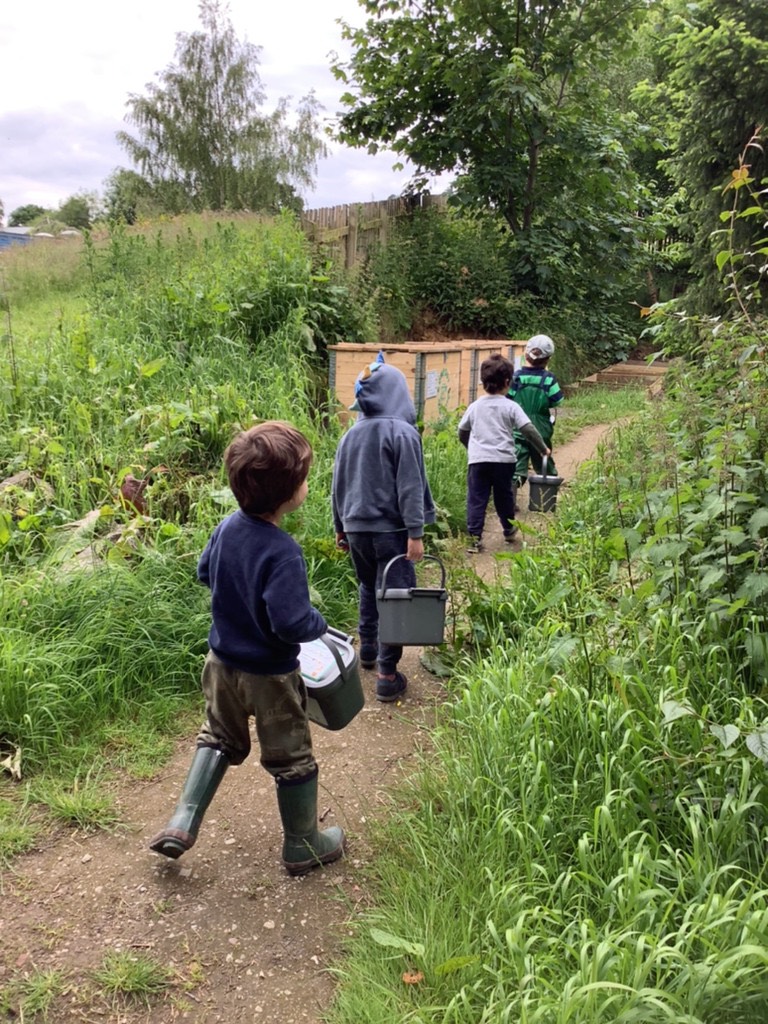
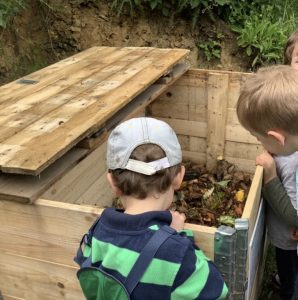

Nurturing Imagination and Creativity
In today’s fast-paced world, where structured learning and organized activities often take centre stage in a child’s life, the value of unstructured, child-led play is sometimes underestimated. The Reggio Emilia approach, an innovative educational philosophy that originated in the town of Reggio Emilia, Italy, places a profound emphasis on the significance of child-led play in early childhood education. In this blog, we’ll explore the importance of child-led play and how it aligns with the principles of the Reggio Emilia approach.
Understanding Child-Led Play
Child-led play, often referred to as free play or unstructured play, is a type of play where children take the lead in choosing what to do, how to do it, and for how long. It occurs when children engage in activities driven by their interests, imagination, and curiosity, rather than following adult-directed instructions. This type of play can involve activities like building with blocks, creating art, exploring nature, or pretending to be characters in imaginative scenarios.
The Reggio Emilia Approach
The Reggio Emilia approach to early childhood education is renowned for its unique perspective on child development and learning. Developed by Loris Malaguzzi in post-World War II Italy, this approach is deeply rooted in the belief that children are capable, curious, and rich in potential. It recognizes that children have their own unique ways of understanding and making sense of the world, and this understanding is a cornerstone of the Reggio Emilia philosophy.
Child-Led Play in the Reggio Emilia Approach
1. **Respect for Children’s Autonomy**: Child-led play is at the heart of the Reggio Emilia approach. Educators in Reggio Emilia schools observe and listen to children carefully, allowing them to express their thoughts, ideas, and interests. This approach respects and values the autonomy of the child.
2. **Emergent Curriculum**: In Reggio Emilia-inspired classrooms, the curriculum is often emergent, meaning it evolves based on the children’s interests and inquiries. Child-led play provides a natural platform for educators to identify these interests and build educational experiences around them.
3. **Nurturing Creativity and Problem-Solving**: Unstructured play fosters creativity and problem-solving skills. When children engage in activities they are passionate about, they are more likely to encounter challenges that require them to think critically and find solutions independently.
4. **Documentation and Reflection**: Reggio Emilia educators document children’s play and learning experiences. This documentation is used for reflection, assessment, and to guide future learning opportunities. Child-led play provides rich content for this documentation.
5. **Collaboration and Social Skills**: Child-led play often involves interaction with peers. Through these interactions, children learn important social skills, such as communication, negotiation, and teamwork.
6. **Environmental Education**: Reggio Emilia-inspired schools often incorporate the natural environment into play. Children are encouraged to explore and connect with nature, fostering a sense of environmental stewardship from an early age.
Child-led play is not merely a leisure activity but a powerful educational tool that aligns seamlessly with the principles of the Reggio Emilia approach. It respects children as competent learners, encourages their creativity, and cultivates a lifelong love for learning. By allowing children to take the lead in their play, we are nurturing the seeds of curiosity, independence, and a deeper understanding of the world around them. In essence, child-led play, as championed by the Reggio Emilia approach, is an investment in a brighter, more imaginative future for our children.
Coaching vs Training
What is the difference coaching vs training?
Training is designed to increase knowledge and skills. Coaching is designed to increase self-awareness about attitude, behaviors, choices, and development needs.
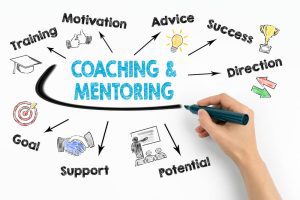
What does it look like in practice?
Training and mentoring are about the transferring of knowledge from teacher to student.Coaching is about enhancing, supporting, and facilitating the practitioner to step in and be actively engaged in their own growth and knowledge. Drawing out the skills and training they already have.
Many practitioners have a wealth of knowledge and so the early years training might not be best for them. Since, and during the pandemic online training has become very popular and lots of companies provide many wonderful courses. We all seem to have lots of certificates and are totally aware of the importance of our Continuing Professional Development (CPD) but are we seeing it in practice?
This is where coaching comes in. Coaching is about working alongside everyday practitioners in the setting, to implement training that they already have. It also provides the opportunity for the practitioner to get a huge amount of knowledge and expertise delivered in the moment.
The obvious drawback with coaching can be the cost! It can vary in price and can be expensive. Settings need to look at the current qualifications and skills they already have and build from there. Are we seeing those skills in practice? If not, coaching needs to be considered. As a trainer this is something I want to implement within our setting. Sharing and showing our skills, knowledge and experience should be key for development.
Coaching is also a wonderful way for positive role modelling to be demonstrated. Many factors influence the behaviour of children in early years settings. The behaviour of people who work closely with children has a great effect and influence. We all cope differently in stressful situations, so having a person to coach and mentor you through challenging times is invaluable.
We want to develop a coaching culture at inspirations. Where everyone feels valued and supported. A coaching culture improves the way we are with each other, but also our interactions with the children. At its core, it is about helping people get from where they are to where they want to go. Whether privately or in a group, coaching empowers people to increase their self-awareness and self-esteem.
Tara Slade
The importance of STEM/STEAM learning in EYFS (Science, Technology, Engineering, Art and Maths)
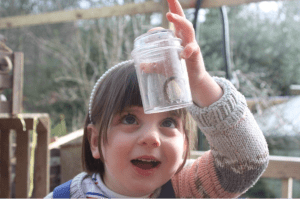
Young children are the ultimate sources of wonder and natural curiosity, with limitless drives to explore. They are the world's natural problem solvers, seeking new and exciting challenges and ways to ‘do’ and improve things. They predict outcomes, test their ideas or questions, spot patterns, estimate and evaluate critically. Through incorporating aspects of STEAM into our child-led-play environment, children are encouraged to develop their resilience and to communicate, work collaboratively and to make compromises.
Each of these skills are aspects of the EYFS Characteristics of Effective Learning. At Inspirations Nurseries I believe that STEAM is naturally embedded in our ethos and pedagogy and should be in all early years education and settings.
STEAM is a multidisciplinary and holistic approach to teaching these subjects, which is what our provision is based on, the areas where learning overlaps. Our outdoor setting/classrooms, art studios and child-led learning approach already provides a rich STEAM enabling environment where children can experiment, explore and have a wonder for their world.
Science is fully embedded in our provision: within the daily and seasonal links to nature, cycles (tadpoles/chicks/weather/water/decomposition) and the equilibrium needed for different types of energy (their transfers and ‘cause and effect’). It is in chemical reactions, materials and their properties, in temperature, size, force and motion.
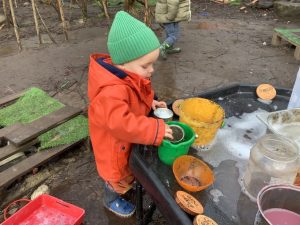 We support our children to experiment with ‘cause and effect’, providing sensory experiences with construction and creative media resources, using containers, utensils and other tools for transforming materials from solids to liquids. We use textured materials and ramps with vehicles to investigate the speed and force of objects in a developmentally and appropriate way.
We support our children to experiment with ‘cause and effect’, providing sensory experiences with construction and creative media resources, using containers, utensils and other tools for transforming materials from solids to liquids. We use textured materials and ramps with vehicles to investigate the speed and force of objects in a developmentally and appropriate way.
In the last few weeks, the children in our toddler room have been blending, stirring, whisking silly soups and potions. They have been measuring ingredients when making pancakes and looking at the capacity of containers in the water trays. Our pre-schoolers have been using magnifying glasses to observe various "minibeasts" collected from various locations around nursery, whilst extending their interest of digging and improving their fine motor skills.
Technology, and tools like projectors, cameras, microscopes, sensory toys, lights, mark making and cutting tools, are part of our continuous provision. We also use online platforms and apps to provide learning opportunities for children to record and observe. Technology helps children to make discoveries and record findings, to explore the consistency, composition and uses of materials and resources.
We have a nursery full of budding engineers, and architects who daily stack, design, construct, connect, and build. They make houses, towers, bridges, and roads for their vehicles and containers, traversing and transporting which extends their own learning journey. As children play, staff promote STEAM in their interactions, provocations and questioning.
Our resident atelierista, provides a wealth of opportunities for extending STEM subjects and skills within the arts and creative play. A curriculum incorporating the arts has been proven to increase creativity, academic performance, motor skills, while enhancing visual learning and boosting higher decision-making and critical thinking skills.
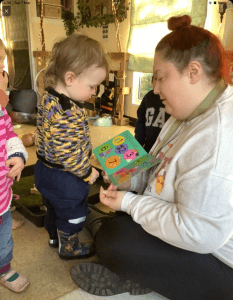 Mathematical literacy is enriched daily through singing and stories. Our environment and the continuous provision of resources, such as containers, funnels, measuring cylinders and loose parts, allow opportunities to compare size, capacities, volumes as well as categorisation of shapes and colour.
Mathematical literacy is enriched daily through singing and stories. Our environment and the continuous provision of resources, such as containers, funnels, measuring cylinders and loose parts, allow opportunities to compare size, capacities, volumes as well as categorisation of shapes and colour.
STEAM takes STEM to the next level by including the process of innovation and creativity. The integration of these principles through the arts fosters a generation of future innovators who can link their learning and skills together, removing limitations and replacing them instead with wonder, critique, inquiry, and innovation.
Kellianne Moulton
Looking Out For Forest Friends
Rounded body, short dark yellow-tipped spines and a short tail – is it a Gruffalo I hear you ask? No, it's the Hedgehog!
Hedgehogs are a picture of cuteness and are largely widespread throughout Britain. In the summer time they spend most of their days sheltering in moss, grass, leaves and hedges. In fact, the reason they are called 'Hedge' hogs is because of where they build and nestle in hedges, bushes and shrubs. The ‘hog’ part comes from the small snorting and grunting sounds they make, which is similar to a pig.
There are a few facts about Hedgehogs, for example;
- They are nocturnal
- They can hibernate
- There are 15 species of hedgehog
- They have 5000 spikes
- Their snout is long to help them forage for food, such as worms, insects and berries
- They are lactose intolerant
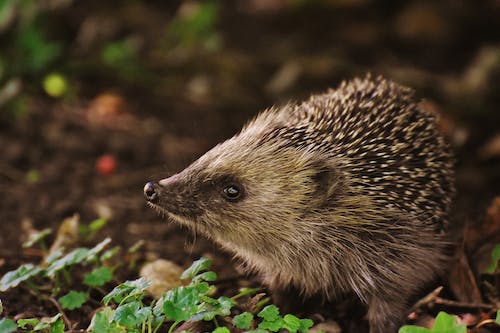 Hedgehogs tend to forage in the evening and can travel for up to 2 miles, that’s a long way for little legs! They are known for being a Gardeners’ Friend and have earned this reputation because of their eating habits. Not only do they enjoy berries and fruit but the staple of their diet is made up from pests that are common in our back gardens such as beetles and caterpillars. This helps preserve the
Hedgehogs tend to forage in the evening and can travel for up to 2 miles, that’s a long way for little legs! They are known for being a Gardeners’ Friend and have earned this reputation because of their eating habits. Not only do they enjoy berries and fruit but the staple of their diet is made up from pests that are common in our back gardens such as beetles and caterpillars. This helps preserve the
fruit and vegetables you may have growing in your gardens.
Vulnerable to Extinction
Sadly, Hedgehogs are at risk, so much so that they are classified as ‘vulnerable to extinction’ and are on Britain’s red list for mammals due to the sharp rate of it’s decline. Hedgehogs are one of the oldest mammals on the planet. They are Britain’s only spined mammal and a national favourite. But their numbers have fallen from over 30 million in the 1950s to less than one million today. More and more is being done to stop these spiky little creatures from becoming extinct. Recently The British Hedgehog Preservation Society ran a successful campaign to ensure that all new housing developments include hedgehog highways. This will help to give hogs the room they need to roam and find food and suitable mates. https://www.countryliving.com/uk/wildlife/countryside/a28604641/hedgehogs-building-rules
A garden can be a haven for Hedgehogs but decking, astroturf, gravel and paving, as well as neat cut back grass with no trees or bushes aren’t much use to our prickly friends. Such things as pesticides not only kill the bugs that they eat but also get into the Hedgehogs diet, causing them to become ill. Therefore, the introduction of Wildlife gardening is helping to maintain these habitable havens and is aimed at creating an environment that is attractive to various forms of wildlife such as Hedgehogs. The move towards this form of gardening and the great work done by the Hedgehog Street campaign has shown that even though there is still a decline in the countryside, in urban and suburban areas things are looking better. Thankfully this means that more and more gardens up and down the country are becoming hedgehog friendly. Is your garden Hedgehog friendly? There is one way you can help...
Get your own hedgehog highway!
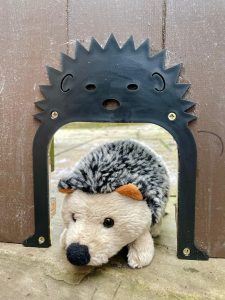
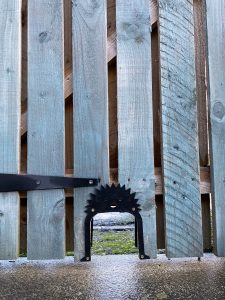
Let's open up our gardens again, to get your own Hedgehog Highway contact Handyman Ian local to the area. He will cut a hole in your fencing and attach a hedgehog frame just like this one for £12
Email: https://www.facebook.com/handyian84 Whatsapp:+44 7740 328619
Get involved in making your garden hedgehog friendly and perhaps we can work together to save this species from extinction.
- Ashleigh
Art vs Craft
What is a craft?
A creative activity with a predetermined outcome and there is nothing wrong with it, it can be a nice way to relax or create a keep sake, particularly for adults. In fact new skills can be learnt in the process and concentration skills can be encouraged. Take for example knitting, and sewing, a skill that needs to be learned with instruction in order to create the desired outcome.
However, at Inspirations we believe there is a time and a place for a craft, and we would much rather encourage unique creativity without boundaries. With everything we do and make in life we draw inspiration from other peoples ideas, take for example the current interest in Jackson Pollock in the Art Studio. His method of painting has inspired us to try it our selves, but when it came to creating this piece of art, through trial and error and experimentation, the outcome is decided by them, and that is the important factor.
Who are we to tell our children what their art should look like?
We believe there are more creative options to crafts. By providing our children with tools, and telling them what to make and how it should look is projecting our ideas onto them, when the children should be at the centre of their own learning. Our role is not to tell a child what colour something should be, and we most definitely shouldn't be giving our opinions on how 'good' something is at the end of a creative session. These restricting activities have the potential for huge disappointment and create a barrier to the child venturing down their unique path of creativity. At Inspirations we use encouragement over praise, and if a child is looking for a comment on their drawing I will try to use factual language such as 'i see you used lots of green!' 'you seemed really focused whilst making that' or 'you must be really proud of that'. Factual statements instead of us giving our opinion will help build self esteem instead of encouraging them to do things to impress others.
We are a place where mistakes are part of the journey, and the process holds more importance than the end result. Open ended activities are important in early child hoods development. Of course they promote imagination and creativity, but they also encourage problem solving skills and social emotional development. Creativity doesn't just include drawing and making, it includes role play, dress up, music, building from cardboard boxes, magnets, loose parts, building blocks..the suggestions are endless and all a part of the 100 ways of learning. They piece together to make each unique child, who has learned new skills and ways of learning through experimenting and ideas, with us there to ask open ended questions.
How can we help support creativity?
Whilst allowing our children to play and learn we can support them by asking open ended questions. They might not always answer, a good sign they are truly engaged, but some questions you can ask at the right time will support them in extending upon their own learning.
- Tell me about that?
- Why do you think…?
- How do you know…?
- I wonder what might happen if you...?
- Why do you think this happened?
- I wonder if you will add anything?
- What can you do about it?
- What do you think would work?
- How do you think it could work?
- Can you do it another way?
- How are these the same?
- How are these different?
- What do you think comes next?
- What else can you do?
- What does it remind you of?
So next time you come to do a craft, why not encourage your child to take a unique spin on it. By removing that set outcome you will find the pressure is gone and creativity flourishes.
-Nathalie
